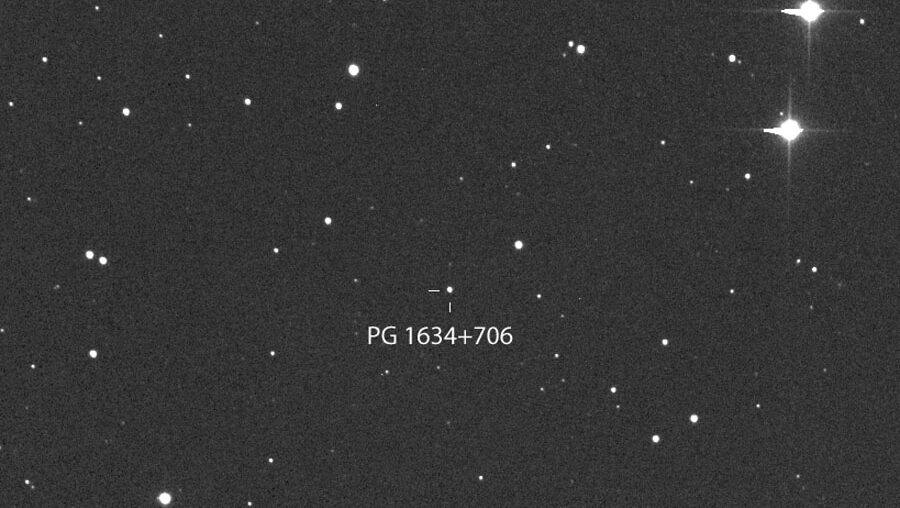
ESA / Hubble, NASA, M. Kornmesser
Sometimes you just need to get away from it all. Quasars are good for that. At the tilt of the telescope they transport the viewer to the far ends of the universe. Traveling great distances also means going back in time. Even the nearby Moon is far enough to exhibit “light lag.” We view its craters and crevasses as they were 1.3 light-seconds in the past, the time it takes light from its craggy surface to reach our eyes traveling at 300,000 kilometers per second. Jupiter’s distance from Earth averages about 36 light-minutes, while a radio signal relayed from Pluto requires about five hours to receive.

Nick Hartman
Once we enter the realm of the stars, our yardstick lengthens from hours to years to centuries. The more distant the object, the further back in time we see it. Every time we bring the Triangulum Galaxy (M33) into focus in our telescopes, we see it as it was 2.7 million years ago, when our early human ancestors shared Earth with now-extinct saber-toothed cats, mastodons, and giant ground sloths.
Quasars permit us to probe much deeper into the past. Powered by supermassive black holes, they reside at the centers of remote galaxies and gush light when they consume hot gas and even the occasional star that happens to pass nearby. Quasars are tiny in comparison to the galaxies they inhabit but are hundreds to thousands of times more luminous. Yet from their great distances, they appear identical to faint stars in telescopes big and small. The one with the greatest apparent brightness, 3C273, fulminates in Virgo at 13th magnitude around 2.1 billion light-years away. It was my first, and I remember how far from home I felt when I first tracked it down in 1980 with my 6-inch reflector.

Stellarium with additions by Bob King
As amateurs we love to push boundaries. Who hasn’t sought the reddest star, faintest planetary moon, or narrowest lunar rill? I like breaking distance records, so I’ve looked at lots of quasars. They’re the only things bright enough to see at cosmological distances. The most distant one that’s visible in most amateur telescopes is PG 1634+706, which is located in Draco, just below the bucket of the Little Dipper. It varies slightly from magnitude 14.2 to 14.7, caused by fluctuations in the rate material funneled into the supermassive black hole.
At 70° north declination, it’s circumpolar from mid-northern latitudes and situated 5.3°south-southeast of 5th-magnitude Eta (η) Ursa Minoris. An easy way to find it is to start at 5th-magnitude Eta (η) Ursa Minoris and star-hop to a zigzag of four stars (magnitudes 6 and 7), then continue to an Aries-shaped asterism of 7th-magnitude stars. Both stellar groups are marked on the map above. About 1° due east of the Aries-like asterism, you’ll spot a pair of 8th-magnitude stars separated by 2.2′ (see map below). The duo will take you directly to the quasar.

Gianluca Masi with magnitudes courtesy of Stefan Karge, Frankfurt Quasar Monitoring
I’ve observed PG 1634+706 several times in recent weeks. Using the star magnitudes shown in the graph below — courtesy of Stefan Karge and his superb Frankfurt Quasar Monitoring site — I estimated its brightness at 14.5. That puts it within the range of an 8-inch telescope at high magnification (250× and up) on a moonless night from a dark northern sky.

Stefan Karge
The quasar’s redshift is 1.337, which indicates that the light left the object some 11.5 billion years ago, some 2 billion years after the Big Bang. As those primeval photons beamed across space, the universe expanded all the while so that the quasar’s current distance — called the co-moving distance — comes to approximately 21 billion light-years. A modest telescope makes a pretty cheap ticket for a round-trip across most of the known universe!
Pick either measure of distance, and you’re time-traveling further into the past than the age of the solar system, a time long before the Sun, Earth, and planets formed. Life, honed by nearly 4 billion years of evolution, was nothing but cosmic dust at that time — the same stuff that forms the dark gash along the length of the summertime Milky Way and compacts under gravity to birth new suns. Now, as then, these fundamental ingredients harbor creative potential beyond imagining. Pondering PG 1634+706’s flickering light, we infer the very essence of our existence.

